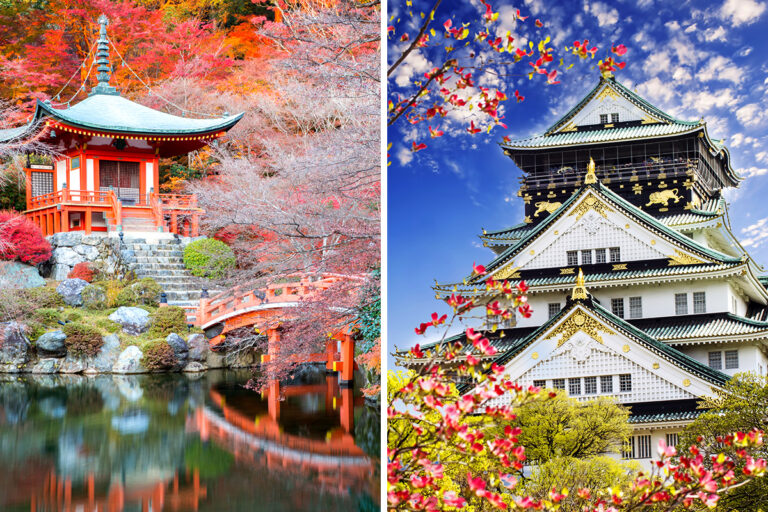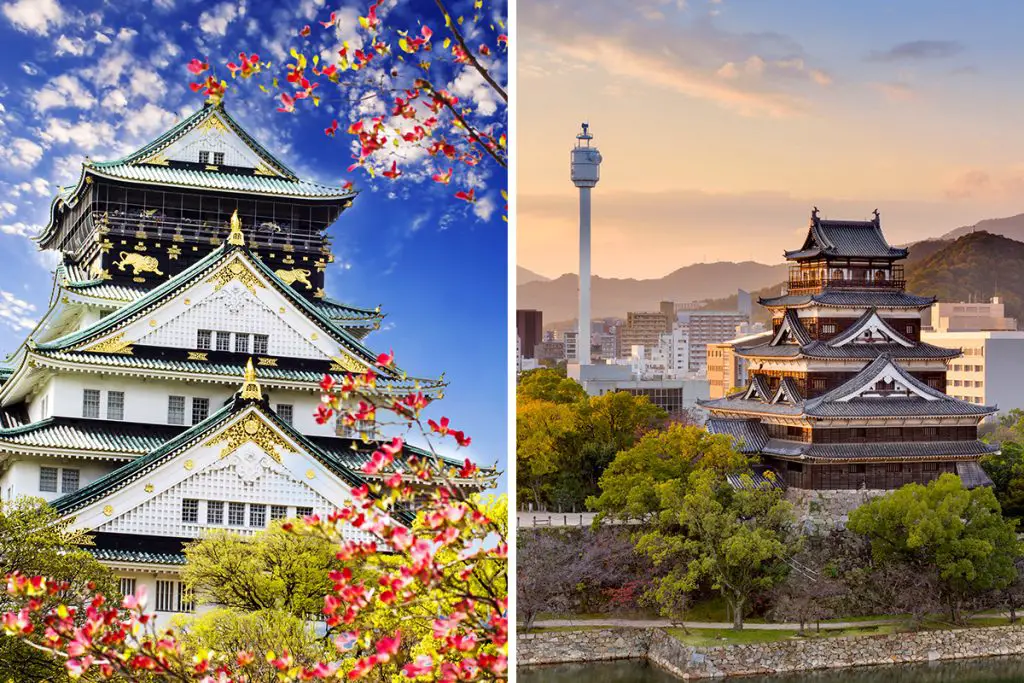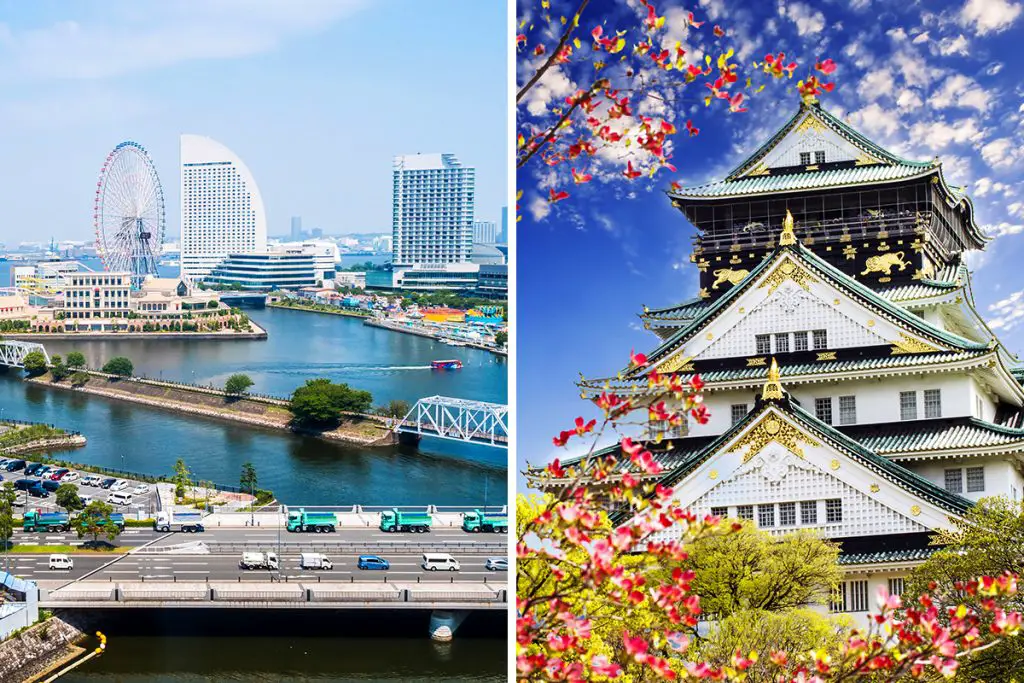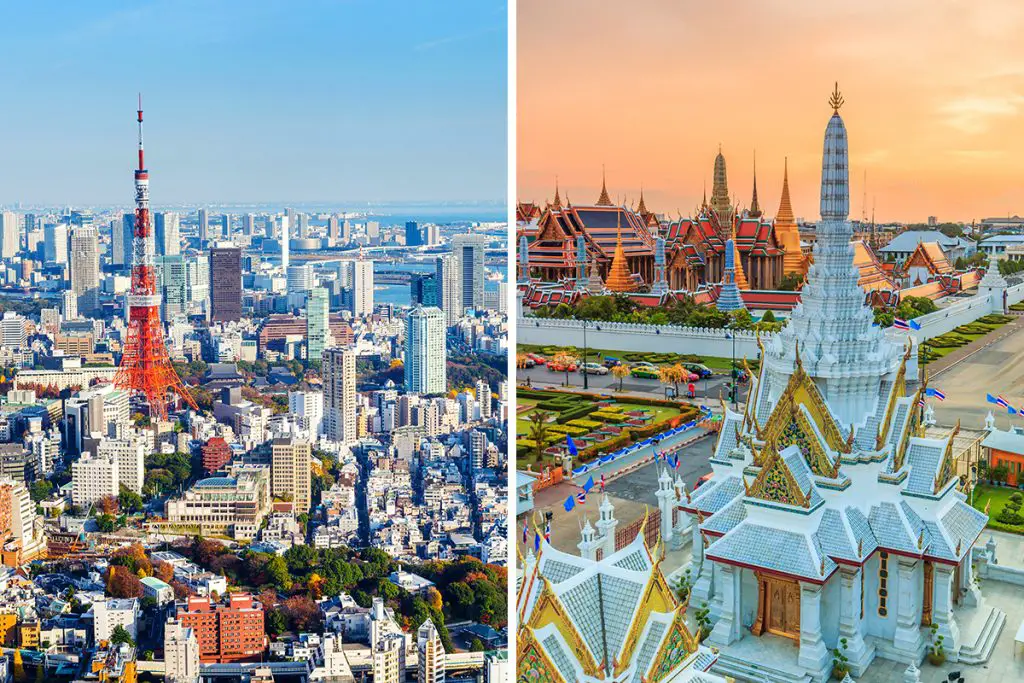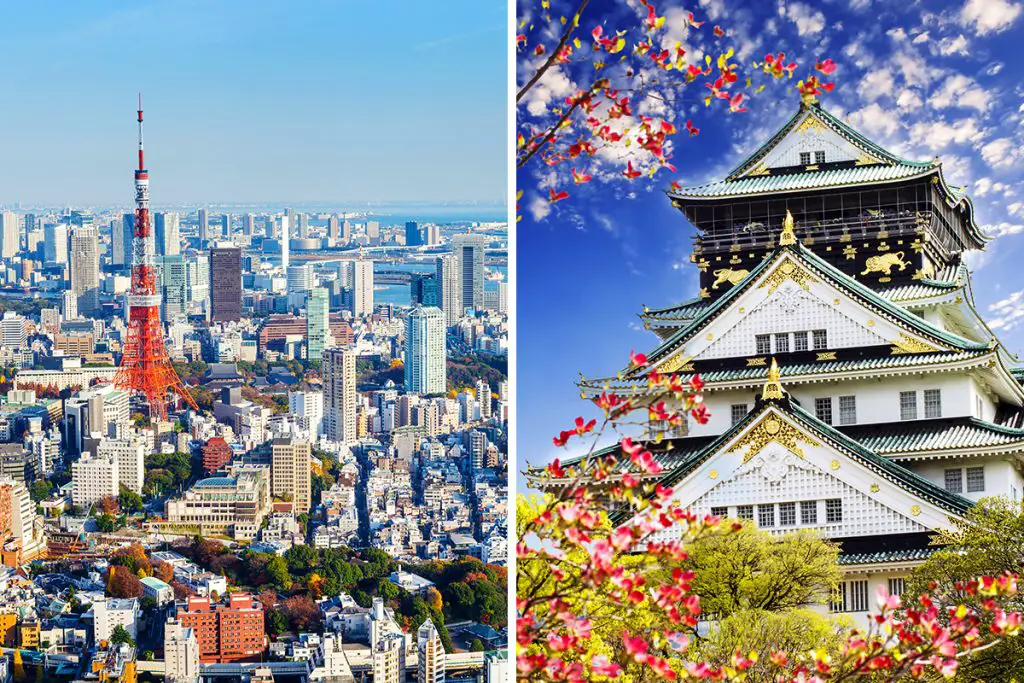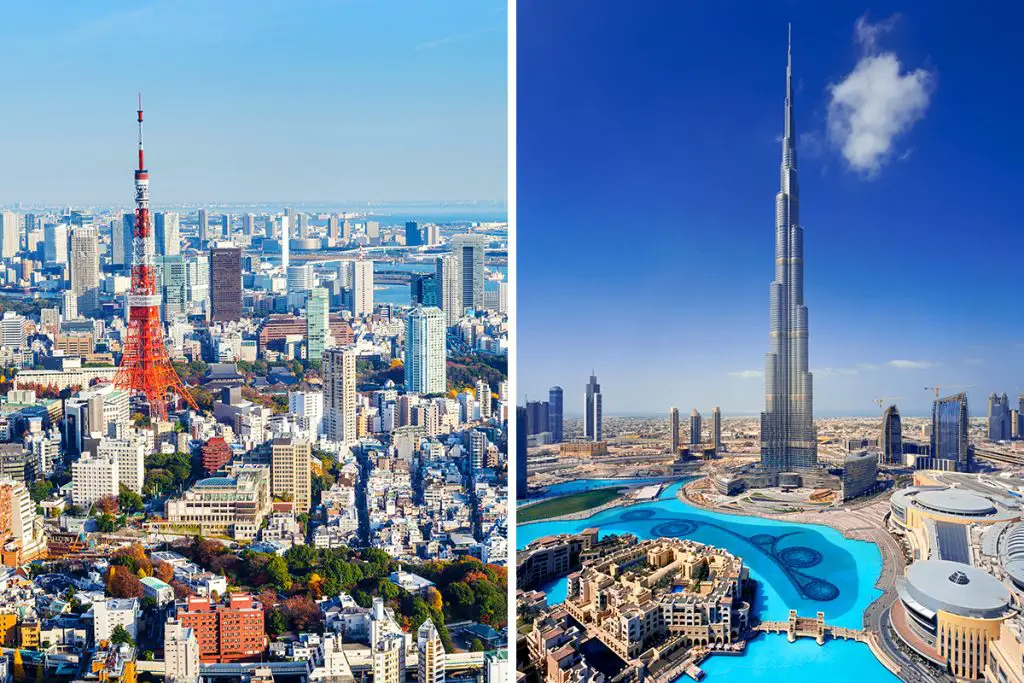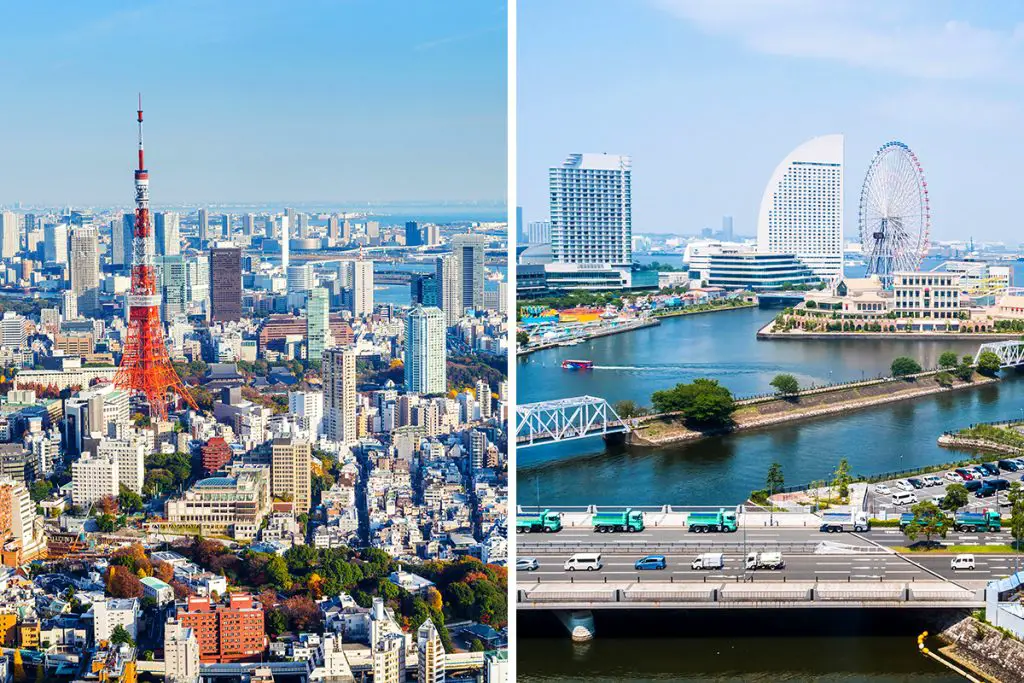The laid-back city of Kyoto exudes a more traditional and calming vibe. Offering the look and taste of old Japan, it’s a staple of any itinerary to the country.
Its overlooked neighbor, Osaka, may not have this charm. But it’s a city with a big personality, always bustling with a lively crowd and buzzing with a seemingly endless list of things to do.
Both are beautiful in different ways, and visiting both cities is worth the trip. But if you can only visit one, choosing between Kyoto and Osaka for your trip will be easier once you get to know them more below.
Kyoto
If you want to get a feel of old Japan, there’s no better host for your vacation than Kyoto. Ancient traditions, centuries-old sites, and ancestral cuisines are alive and well here in the city. With this, the laid-back and charming city of Kyoto transports you back in time in more ways than one.
What Makes Kyoto Unique?
Unwind at Kyoto’s Tranquil Gardens
Japanese gardens are meticulously designed down to every last element. And despite having several types, each one never fails to evoke a sense of tranquility.
You’ll find many of the best gardens in temples across the country. But with over 1600 temples in Kyoto, the city is dense with incredible gardens. And because of this, the city is the best place in the country for you to discover the beauty of Japanese gardens.
Find serenity in a Zen garden, a distinctive style that doesn’t feature bodies of water. Instead, these gardens use gravel and sand to mimic an ocean or river. Thus, Zen gardens are also called dry landscape gardens.
The most famous garden in Kyoto is a Zen garden, one found at Ryoan-ji Temple. This garden features 15 stones of various sizes, laid out in five groups across a rectangular sea of white sand.
Strolling gardens are another type of Japanese green oasis. So if you fancy walking around in a calm, scenic wonderland, these gardens are perfect for you.
One of the best strolling gardens in the city is the Katsura Imperial Villa. This villa garden dates back to the Edo Period, and at the heart of this garden lies a vast pond of glistening waters from the Katsura River.
The pond features five islands of various sizes. And you can either walk around the pond or ride a boat and visit the islands as you enjoy the greenery around you.
Kyoto’s many green oases aren’t limited to gardens though. If you’re seeking to connect with nature, why not visit the bamboo forest of Arashiyama?
The Sagano Bamboo Forest is one of Kyoto’s most famous landmarks. Here, you’ll find bamboo so tall that it looks like they’re touching the sky.
And because it’s so dense, there’s only a hint of light coming through the forest. But this adds a dramatic, magical vibe to the forest, giving you an experience like no other.
Step Back in Time to Beautiful Historic Landmarks
If you love the feel of old Japan, there’s no better city to host your vacation than Kyoto. In the distant past, the city was Japan’s imperial capital.
It was first settled in the 7th century. But according to archaeologists, it may have existed before the 6th century. Kyoto’s Shimogamo Shrine even dates back to around the same time.
And because Kyoto remained almost untouched during World War II, it retained much of its old buildings. So today, you can still see the rich cultural heritage of the Imperial family centuries ago.
Strolling around Kyoto feels like you’re reliving stories from a history book.
Look up and you’ll find the sky undivided by skyscrapers. Explore neighborhoods and you’ll find a wealth of traditional wooden townhouses. You’ll find shops lit by gas lamps and people walking the streets in their kimonos.
But for the best feel of old Japan, you have Kyoto’s historical landmarks to explore. Kyoto has over 1600 temples, more than 400 shrines, and even palaces and castles.
Kyoto has 17 UNESCO World Heritage Sites. This high concentration of such is one of the unique things about Kyoto. And many of these heritage sites are temples, such as:
- Kinkaku-ji Temple (The Golden Pavilion)
- Ginkaku-ji Temple (The Silver Pavilion)
- Ryoan-ji Temple
Another UNESCO site in the city is not a temple, but a castle. The Nijo Castle was the home of the Tokugawa Ieyasu, which are the first Edo Period shoguns.
Some historical landmarks in the city don’t have this distinction. But they’re still some of Kyoto’s best landmarks, and they’re still beloved by both locals and tourists. And the most popular one of the bunch is the Fushimi Inari Shrine.
This Shinto shrine is one of Kyoto’s most recognizable sites. This shrine is famous for its 10000 colorful Torii gates leading to Mount Inari.
The Birthplace of Geisha Culture
With their colorful kimonos, white-painted faces, and intricate hairstyles, geishas are a sight to behold. Geishas are a living example of Japanese traditional culture. And despite their popularity worldwide, geishas are quite elusive across Japan.
But there’s no better place to explore the secret world of geishas than Kyoto, the birthplace of this culture. You may see geishas in the streets, but they’re often too busy to stop and say hi to you.
Instead of leaving geisha encounters to chance, you can visit the Gion district, the center of Kyoto’s traditional arts.
You can attend geisha dinners at an ochaya, which is a tea house. Here, your dinner will take place in a tatami room while geishas entertain you and keep your glass filled.
Ochayas are quite exclusive though, and they’ll only allow trusted customers to enter. Some aren’t as restrictive though, allowing moneyed tourists to enter. But the high price tag isn’t for everyone.
Don’t lose hope though, as there are still several ways to experience this culture! Here are some of your options:
- Performances: Gion Corner is a theater that offers daily geisha performances. This includes a maiko dance.
- Miyako Odori: This is one of the four spring geisha shows in the city. Every April, you can watch dance performances by maikos and geishas!
- Geisha Tea Ceremony: With this, a geisha will show you the proper way to make tea as they prepare one for you. Other than sipping some tea, you can also taste some sweets and interact with the geisha. Maikoya is the only place in Gion where these ceremonies occur daily.
- Geisha Makeover: You can even transform into a modern-day geisha in Kyoto! A professional does the work for you, from dressing you into a kimono, giving you white face makeup, and fixing your traditional hairstyle! After this, a photographer will take pictures of you in a studio.
Enjoy Kyoto’s Many Cultural Activities
Being Japan’s cultural mecca, experiencing tradition in Kyoto goes beyond sightseeing. In many ways, you can be part of the action of centuries-old traditions too. And the best way to dive into the city’s rich history is to sign up for some cultural activities!
Matcha Tea Ceremony
A quintessential Japanese flavor, matcha-infused food is everywhere in Kyoto. But if you want a more traditional and fun route to taste it, take part in a matcha tea class. This way, you can take part in the matcha tea ceremony process, from start to finish.
With this, you’ll make your matcha powder with a heavy granite wheel. Once done, a tea master will show you how to whisk matcha the proper way for a frothy consistency. After which, you’ll get to taste your creation!
Shodo Calligraphy Class
Shodo is an art form, an artistic way of handwriting that dates back to the 5th century. Whether you’re a beginner or an expert, there’s a class that’s right for you. Calligraphy Kyoto is the best place to try your hand at shodo.
A beginner class costs around 50 USD and an expert will show you the basics of calligraphy. If you want to be an expert at this, you can take the 10-hour license acquisition course!
Sushi-Making Experience
You can always find good sushi everywhere in the world. But you can only learn about the art of sushi making in Japan.
Several places in Kyoto offer sushi-making workshops. An instructor will take you through the step-by-step process of making one. And in some places, you’ll get to wear a traditional Japanese outfit as you prepare your meal!
Have a Feast Fit for a King
Being Japan’s former imperial capital, Kyoto’s cultural importance is also evident in its cuisine. Kyoto has thousands of years of culinary refinement under its belt. And it offers a mastery of traditional food that only comes with an old city brimming with rich culture.
You won’t only be sampling the beloved classics of Japanese cuisine here. Kyoto’s food scene is ever-evolving, using traditional methods and blending them with a modern twist. The result is a distinctive flare in unusual, local favorites you won’t find elsewhere.
You have tons of incredible food options in the city, from the tastiest mackerel sushi to a big bowl of warm nishin soba. Other favorites include a hearty meal of the following:
- Yudofu: A dish made of tofu in a warm kombu broth.
- Kyoyasai: This word translates to “Kyoto vegetables”, and Kyoyasai features veggies from the city itself. The most popular versions include kamonasu eggplants, Kujo green onions, and mibuna greens!
- Warabi Mochi: A sweet, chewy delight that uses bracken-starch flour instead of tapioca or potatoes. The use of bracken starch flour gives a softer texture and a distinct flavor.
But with so much more to taste in Kyoto, why taste dishes one at a time when you can have a multicourse meal? There are a few types of these, fit for any palate and every diet:
- Kaiseki Ryori: This is the traditional style of Japanese fine dining, once enjoyed by the Imperial ruling class. It offers an elaborate selection of dishes that vary each time. But the rice dishes, tofu, and fish are a staple in Kaiseki Ryori.
- Shojin Ryori: This is much like Kaiseki Ryori, but it differs in that it presents a diverse array of Kyoto’s best vegetarian dishes. Shojin Ryori only serves healthy, seasonal veggies.
- Obanzai Ryori: You won’t get a culinary experience as local as this. Obanzai Ryori serves simple home-cooked meals in authentic restaurants across the city. It uses recipes and food that have endured through generations. And for a meal to be Obanzai, at least half of its ingredients must be locally sourced.
Osaka
There’s more to the fun and exciting city of Osaka than being the nation’s kitchen. It has the vibrancy and amenities of a big city, without the crowded feeling of being one. Osaka has an incredible variety across all its allures, from food to shopping, and plenty more!
What Makes Osaka Unique?
Osaka Is Japan’s Bustling Kitchen
Osaka is affectionately called Tenka no Daidokoro, which means “the nation’s kitchen”. This moniker was due to the city’s importance as a trading hub during the Edo Period. But it’s now used today to signify Osaka’s reputation as Japan’s culinary mecca!
Unlike Tokyo or Kyoto, Osaka’s food scene offers a big feast without a high price tag. So put on your stretchy pants and let Osaka tantalize your taste buds and fill your belly!
A great introduction to Osaka’s incredible food starts in the city’s streets. Delicious Japanese favorites are on every corner of the city. And here’s where you’ll find the city’s staple foods that the locals have perfected over the ages.
Some of the must-try, tasty delights of Osaka include the following:
- Okonomiyaki: A savory egg pancake mixed with shredded cabbage and prawn, meat, or octopus. Grilled to perfection, it’s then served with a savory-sweet sauce, mayonnaise, and seaweed!
- Takoyaki: Another one of the iconic treats here has a similar batter to okonomiyaki. These are bite-size balls that contain octopus, with various veggies inside. Crunchy on the outside and gooey on the inside, these are addictive delights!
- Kitsune Udon: You can get udon noodles everywhere in the country. But Osaka is the birthplace of the kitsune style. This variety uses a dashi fish broth and deep-fried tofu skin that’s cooked slowly in sweet soy sauce.
If you’re looking for a more upscale dining experience, Osaka has your back. Tokyo and Kyoto aren’t the only Japanese cities for these. Osaka is among the top five cities in the world with the most Michelin-starred restaurants! Osaka has close to 100 of these restaurants.
One of them is Zuboraya, the best place to get tasty fugu in the city. Then there’s Mizuno, which is famous for its okonomiyaki. And if you’re craving cold soba, make your way to Soba Takama.
Get a Feel of Modern and Ancient Japan in One Day
In Osaka, you don’t have to choose between seeing old or modern Japan. You get the best of both worlds here, in one place!
Get a Glimpse of Old Japan
Osaka Castle is a stunning historic structure surrounded by a beautiful urban park. This combination makes it one of the city’s most famous attractions.
The castle itself dates back to 1583. Inside, it features a museum where you’ll find ancient artifacts and samurai costumes.
Outside, you’ll see a sprawling park filled with hundreds of cherry trees. So this is the perfect place to visit during spring when the park blooms with soft pink!
Kyoto’s festivals also make you feel like you’re stepping back in time.
Tenjin Matsuri is a festival that dates back to the 10th century. Every late July, there are processions of small shrines in the downtown area and along the river. You’ll also find carnivals, loads of street food, and an incredible fireworks show!
You can even get cultured a the National Bunraku Theatre, where you can watch a puppet theatre. This art form, bunraku, has been around since the Edo Period.
Experience Modern Osaka’s Vibrancy
If you’d rather see Osaka’s urban allures, start with the Umeda Sky Building. This glass and steel monolith is actually two skyscrapers joined at the top. Head up to the rooftop and you’ll find a floating garden in a glass dome suspended between the two.
Osaka is also the home of the few Universal Studios theme park in the world. Get your thrill at a Jurassic Park ride, see some Minions, or explore the Wizarding World of Harry Potter!
A quirkier attraction in Osaka is the Cup Noodles Museum. Take pictures at the Instant Noodles Tunnel, which features 800 noodles packages with some dating back to the 1950s. Or, you can create and design a cup of your instant noodles for a fun souvenir to bring home!
A City That Spoils Shopaholics
Osaka is a city where you can shop until you drop, no matter your budget! You’ll find all kinds of goods no matter your taste, from long shopping arcades to malls to streets. There’s a spot for you if you want upscale, designer goods or if you love a good bargain at discount chains and thrift shops.
Shopping in Osaka is more tempting than in other major cities in the country as the prices are lower here. And if you bring your passport with you, you’ll get a tax-free rate, knocking off 8% on the price!
Knowing where to start can be confusing with the plethora of shopping hotspots in the city. So if you want a little bit of everything, head to Tenjinbashisuji first.
Tenjinbashisuji is a 1.6-mile-long (2.6 km) pedestrian shopping street, the longest in Japan. It’s filled with over 600 establishments to tempt you to open your purse. You’ll find everything you need from upscale brands to the latest gadgets to kitchen utensils!
If you’re looking for specific items, there’s a shopping hub for you in the city.
For high-ticket, luxury items, head to Shinsaibashi or Midosuji. DenDen Town is a haven for electronic goods. Meanwhile, Amerikamura and Nakazaicho are paradises for vintage finds.
Immerse Yourself in Its Legendary Night Scene
Other than its amazing casual eats, Osaka is also known for its fun, outgoing locals. This fun-loving crowd sets the tone for the city’s nightlife, and they make drinking in Osaka a vibrant and memorable experience!
And much like its food scene, partying in Osaka doesn’t need deep pockets. So you can end your day with a bang, without anything holding you back!
If you don’t know where to start, start your exciting night out at Dotonbori. This vibrant entertainment area is the colorful heart of Osaka’s night scene. This district is brimming with flashy neon lights, towering signs, and an extensive variety of bars.
It’s the best spot to go to an izakaya, which is a traditional drinking house. This combines two of the best Osaka has to offer: plates of tasty food and loads of beer to go with them! If you want something more familiar, Dotonbori also has tons of Western-style craft beer bars.
There are still other nightlife venues in the city. From host bars to tachinomi, there are tons of places to sample Osaka’s night scene.
But if you want to dance the night away, Namba is the place for you. This district is full of nightclubs that are blasting music all night. And if you need to sober up, head to its many 24-hour ramen joints to warm up your belly!
If drinking isn’t your thing, diving into Osaka’s comedy scene may tickle your fancy. The city has a renowned comedy club scene worth exploring. You can get a night full of laughs at ROR Comedy Club, which offers English standup shows.
Take a Step Back and Relax at an Onsen
After a long day of exploring Osaka, it’s easy to go on a rejuvenating retreat and soothe your aching body here. Onsen and Sento, which are thermal and public baths, are aplenty in the city. These baths have been around for thousands of years, and they’re still regularly enjoyed by locals today.
Onsen are an integral part of Japanese culture. Not only do they offer relaxation, but they’re believed to be a treatment for chronic diseases. And onsen provide a cultural experience like no other, especially because they’re set in beautiful places.
You’ll find some onsen hidden away in lush forests, while others are by mountains. But you’ll find no shortage of spas within the city for you to easily visit!
A popular option is Nose Hot Spring, an authentic onsen with a view of cherry blossoms during spring and maple leaves during fall. At Nantenen, you can get a hot spring-and-lunch package of delicious food. And at Tenjin no Yu, if you want a more luxurious hot spring.
But none of these can top the onsen experience at Spa World. Spa World feels more like a theme park of hot springs, as it has two floors of glorious hot tubs and saunas!
One floor focuses on Asian spas, with Persian- and Bali-inspired themes, and features a Japanese outdoor pool. The other floor has a European spa, which makes you feel like you’re in Greece, Finland, or Ancient Rome!
Spa World goes more than that as far as amenities go. It also features an amusement pool, a stone spa, and a gym. To top it off, there’s a salon, restaurant, and hotel here, almost everything you’d need for unwinding!
Which Is Better – Kyoto or Osaka?
The better city between Kyoto and Osaka will solely depend on your preferences or what you want to do on your trip.
Kyoto is reminiscent of old Japan, and it’s the place to be for history and culture. The more laid-back of the two, Kyoto feels less crowded and quieter.
Kyoto is the best place in Japan to see temples and shrines. The city has a whopping 17 UNESCO World Heritage Sites for you to explore.
Taking it a step further, Kyoto is where you can stay in a ryokan, which is a traditional Japanese inn. It’s a memorable experience you won’t find elsewhere.
Meanwhile, Osaka is a sleek, modern city that offers big-city life. A constant buzz here energizes you, thanks to its relaxed and outgoing locals.
You may have a ton to do during the day in Kyoto, but Osaka has plenty more allures at night. The latter is better for night owls as it’s one of the best nightlife cities in Japan!
Foodies may love Osaka more as its incredible food scene is also much cheaper. Although Kyoto is better if you want to sample traditional cuisine. Shopaholics, too, will favor the city as it has an endless stream of shopping hubs.
FAQ
Stay in Kyoto or Osaka?
Staying in Kyoto or Osaka is a different experience. And depending on what you want out of your trip, one of these two will be better for you.
Osaka has a wealth of affordable hotels and hostels, some of which are set in old houses. But if you’re looking for traditional stays, there’s no better place to stay than Kyoto.
Kyoto is famous for its traditional ryokan inns. They’re the perfect place to experience Japanese hospitality in a tranquil environment. You can choose from casual to luxurious inns, depending on your budget.
You’ll be sleeping on a futon in a tatami room to get a feel of the local lifestyle. Plus, these ryokans also offer a Japanese breakfast!
Kyoto is a great place to stay if you want to visit centuries-old landmarks. It can be a tiring day visiting them all, so you need a place nearby to rest.
But if you’re all for modern allures, stay in Osaka instead. Staying here gives you all the time in the world to explore its legendary nightlife, one of the best in Japan!
Osaka also has more hotel rooms than Kyoto, so you’ll have a better chance of finding a room here.
Kyoto or Osaka as Base?
Comparing the two head-to-head, Osaka is a better base than Kyoto. And it’s not only because Osaka is full of cheap hotels, and Kyoto is full of pricey ones. But it’s also because Osaka is a more well-connected city than Kyoto.
Osaka has a bit more direct routes to major attractions around the area. In fact, if you go around Japan to or from Kyoto, several transport options need you to go through Osaka first.
Thus, Osaka is an excellent base for day trips.
For example, a direct trip from Osaka to Hiroshima takes around 1 hour and 30 minutes. But if you travel to Hiroshima from Kyoto, you need to make a switch in Osaka, adding 15 minutes more to your trip.
Traveling to Kobe takes only 25 minutes of travel time from Osaka. If you do this from Kyoto, you’ll have to stop by Osaka again. And the total travel time will be around 55 minutes.
To add, Osaka is also a great base because it’s full of things to see and do from day to night. While Kyoto has tons of exciting restaurants to try at night, most of its allures are only limited to the day.
Is Osaka Cheaper Than Kyoto?
Both cities are quite pricey to visit. But if you’re a budget traveler, Osaka may be better for you as it’s a cheaper destination. Kyoto, being more touristy, is more expensive especially when it comes to food and accommodation.
The average daily expense in Kyoto is around 79 USD, while it’ll only be around 77 USD. If you want to get a breakdown of these costs, you’ll find them below.
A hotel or hostel in Kyoto, for one, will set you back 47 USD in Kyoto and only 39 USD in Osaka. But if you need a room for two, expect to pay around 94 USD in Kyoto and 78 USD in Osaka.
The cost to get around the city each day costs only around 8 USD in Kyoto. Osaka is more expensive as you have to spend 13 USD daily.
Daily meals cost around 22 USD on average for both cities. Osaka has more street food options, though, for cheap treats.
The same goes for alcoholic drinks for a day. In both cities, it’ll cost around 11 USD daily.
Daily entertainment costs for tickets, shows, and the like, cost around 15 USD in Kyoto and 17 USD in Osaka.
Kyoto Aquarium vs. Osaka Aquarium
Osaka Aquarium Kaiyukan is one of the world’s largest and best of its kind. It’s home to over 29000 animals across more than 600 species. They’re all housed in environments that mimic their natural ones in exciting exhibits.
One is Aqua Gate, an underwater tunnel that features a diverse array of marine life swimming around. The massive Pacific Ocean Tank showcases giant whale sharks. At Aquabeat, you can marvel at majestic jellyfish floating around freely.
A must-see in the aquarium is the New Interactive Area. Here, you can see animals so up close, you can even touch them! At the Maldives Zone, for example, you can touch rays and sharks!
Kyoto Aquarium is smaller, home to 15000 creatures of 250 different species. This aquarium not only features creatures from the sea, but also from the rivers in the city! Some of its famous residents include giant salamanders, fur seals, and dolphins.
Kyoto has two water tanks that recreate the Yura and Kamo Rivers in the Rivers of Kyoto Zone. Then there’s the Kyoto Woodland Zone which mimics the woodlands right outside of Kyoto. Here you’ll find catfish, carp, frogs, and more animals that live in rice fields and irrigation canals!
Are Kyoto and Osaka the Same?
Kyoto and Osaka aren’t the same places, as they’re two different cities. They’re neighbors in the Kansai region, which is on Japan’s main island, Honshu.
Kyoto is the capital city of Kyoto Prefecture. While Osaka is the capital and the most populated city in Osaka Prefecture.
Kyoto to Osaka Distance
Kyoto and Osaka are quite close. The straight-line distance between these two cities is around 27 miles (43 km). But this estimated distance isn’t applicable for land travel.
If you were to travel by land, the shortest route to take is via Second Keihan Road. On this route, Osaka is only 35 miles (56 km) away from Kyoto. And if you were to travel on a train between the two, you’ll cover a distance of 24 miles (39 km).
Osaka to Kyoto
The only options on your journey from Osaka to Kyoto are a train or bus. And if you’re set on traveling by train, you have tons of options to fit your budget and preferences.
The fastest train option is the Tokaido Shinkansen, which has a travel time of 15 minutes. Tickets for this train cost around 4 USD, but you’ll need to pay for a seat fee too. This’ll cost around 7 USD during the off-season and 24 USD for a green seat.
Then there’s the second-fastest train, the JR Kyoto Line. This has a travel time of 30 minutes. And it costs around 4 USD.
Another option is Hankyu Railways, which will take you to Kyoto in 45 minutes. Tickets for this train cost around 3 USD.
The last option is Keihan Railways. This is the slowest option, as it completes the trip in 55 minutes. Tickets for this also cost around 3 USD.
If you don’t want to travel by train, you can do so by bus. A bus will take you to Kyoto in 2 hours, and tickets cost around 7 USD. You can catch one at Universal Studios, Namba, or Hotel Keihan Universal Tower in Osaka.
How Long Does It Take From Osaka to Kyoto?
The duration of your trip from Osaka to Kyoto depends on your chosen transportation.
You can choose between a train or a bus. The former is the fastest option. And there are several trains to choose from on this route, each with varying speeds.
If you take the fastest train, Tokaido Shinkansen, you’ll be in Kyoto in 15 minutes. Take the JR Kyoto Line and you’ll complete your trip in 30 minutes.
You also have the option to ride trains by private companies.
The Hankyu Kyoto Line will take you to Kyoto in around 44 minutes. This is the cheapest option if you don’t have a JR Pass. Another option is the Keihan Main Line, which takes you to Kyoto in around 55 minutes.
If you choose to take the bus, you’ll reach Kyoto in around 2 hours. But keep in mind that this estimated travel time doesn’t consider traffic. With this, the actual travel time may be longer than expected.
An option you may want to consider is a taxi, as it’ll take you to Kyoto in around 1 hour and 30 minutes. But like the bus, you have to consider delays due to traffic on this option too.
Osaka to Kyoto by Train
If you’re thinking of traveling from Osaka to Kyoto by train, you have four options to choose from.
The fastest train is Tokaido Shinkansen. This train takes you to Kyoto in only 15 minutes, but this convenience comes with a price. A ticket costs around 11 to 21 USD for regular tickets and around 24 USD for a green seat.
You have three shinkansen options here, which are Nozomi, Hikari, and Kodama. Nozomi is the fastest of the bunch. But if you have a JR Pass, you can only use it on the Hikari and Kodama trains.
Another option is the JR Kyoto line, which is a Special Rapid train. It’s the quickest, non-bullet train option as it has a travel time of only 30 minutes. Tickets for this train cost around 4 USD, or free if you have a JR Pass.
The Hankyo Kyoto line has a travel time of 45 minutes. This option offers easy access to western Kyoto’s popular attractions.
Then there’s the Keihan Main Line, a limited express train that takes you to Kyoto in 55 minutes. This option stops near many of Kyoto’s famous sites.
Both the Hankyo and Keihan lines cost around 3 USD.
Osaka to Kyoto Train Price
The train price from Osaka to Kyoto depends on the train you choose for your trip. On this route, you have four trains to choose from.
For the fastest journey, choose the Tokaido Shinkansen, which is a bullet train. The base fare for these trains is around 4 USD. But you need to pay a seat fee on top of this.
If you buy tickets with unreserved seats, the fee is around 7 USD. If you buy tickets with reserved seats, you’ll pay around 17 USD more. And if you get a green seat, which is equal to a business class, the seat fee is 24 USD.
For non-bullet train options, you have the JR Kyoto Line, Hankyu Kyoto Line, and the Keihan Main Line. These three roughly cost 4 USD.
If you have a JR Pass, you can ride the JR Kyoto Line for free. This pass does not apply to the Hankyu and Keihan lines as these two are privately owned.
Keep in mind that these prices are only estimated. Ticket prices change from time to time, depending on several factors such as the season.
Distance From Osaka to Kyoto by Train
The distance between Osaka and Kyoto by train is around 24 miles (39 km).
Kyoto to Osaka Train Time
Generally speaking, trains can take you from Kyoto to Osaka in less than an hour. But depending on your chosen train, your actual travel time will vary drastically.
The fastest option is taking a shinkansen, or a bullet train, to Osaka. This option takes you to your destination in only around 14 minutes!
You can travel that fast from Kyoto to Osaka on the fastest bullet trains, which are Nozomi and Hikari. Both are equally fast. The difference is that you can’t use your JR Pass on the Nozomi train.
There are also trains run by private companies on this route. These are the Hankyu Kyoto Line and the Keihan Main Line.
The Hankyu Kyoto Line takes you to downtown Osaka in only around 44 minutes by a limited express train. Make sure to take a limited express as the other train options are slow since they take many stops along the way.
The last option, the Keihan Main Line, takes you from Kyoto to Osaka in around 51 minutes. Like the Hankyu Kyoto Line, make sure you take the limited express train option.
Osaka to Kyoto by Bullet Train
Taking a bullet train, or a shinkansen, is the fastest, most efficient, and most comfortable way to travel from Osaka to Kyoto. These run from the Shin-Osaka Station to the Kyoto Station.
You have three bullet train options to choose from here. There are the Nozomi, Hikari, and Kodama trains.
The fastest train options here are Nozomi and Hikari. These bullet trains will take you to Kyoto in only around 15 minutes!
If you have JR Pass, you cannot use it on the Nozomi train. So if you want to use it, the Hikari train is the best option.
When opting to travel on a bullet train, you’ll receive two types of tickets. One is the base fare, which costs around 4 USD from Osaka to Kyoto. But you have other fees to pay, and this will depend on the seats that you buy.
You’ll pay around 7 USD for an unreserved ticket, bringing the total ticket price to 11 USD. If you buy reserved seats, you need to pay an extra 17 USD, bringing the total cost to 21 USD. And if you’re getting a green-car seat, which is the business class option, you’ll pay around 24 USD.
How Much Is the Bullet Train From Osaka to Kyoto?
The cost of traveling on a bullet train from Osaka to Tokyo starts from 11 USD. But this price applies to tickets with unreserved seats.
If you buy tickets with reserved seats, you’ll spend around 21 USD. And if you get tickets with a green seat, you’ll pay around 24 USD for your trip.
Keep in mind that these prices are estimates based on the off-season prices. During the peak season, you can expect more-expensive tickets.
Kyoto to Osaka Shinkansen Schedule
Around 33 trains travel from Kyoto to Osaka daily, departing every 10 to 15 minutes. There are morning, afternoon, evening, and night trains traveling on this route each day. With these many options, you can catch a train that fits right into your schedule.
The first train of the day departs at around 6:55 AM. The latest morning train departs for Osaka at around 11:46 AM. You have around 10 daily morning trains to choose from on this route.
For afternoon trains, the first train starts making its way to Osaka at around 12:07 PM. The latest afternoon train starts its journey at around 5:46 PM. There are around 11 afternoon trains to choose from on this route.
In the evening, the earliest train you can catch departs at 6:07 PM. The latest train begins its trip at around 8:33 PM. Around 6 evening trains travel between Kyoto and Osaka each day.
If you want to take the night train, the earliest one leaves at 9:07 PM. Meanwhile, the last evening train departs at around 11:32 PM. You have around 6 night trains traveling this route daily.
Osaka Station to Kyoto Station
When traveling from Osaka Station to Kyoto Station, you only have one option. And that is to take the JR Kyoto Line.
With a JR Kyoto Line, your trip starts at the Osaka Station and ends at the JR Kyoto Station.
These are Special Rapid trains, the fastest, non-bullet train options. These trains only make stops at major or frequently used stations.
On this train, you’ll reach your destination in around 30 minutes. The ticket price for this train costs around 4 USD. If you have a JR Pass, you can use it on this train to save some money on your trip!
Keep in mind that these prices are estimates for the off-peak season. Ticket prices change from time to time, so it’s better to check tickets online for more accurate prices.
Osaka to Kyoto by Car
Driving from Osaka to Kyoto is a great travel option. But this is only possible if you have an International Driving Permit.
You’ll find several car rental suppliers in Osaka. Car rentals can be as low as 37 USD per day for a standard car, such as a Nissan Note. A bigger car like a Crown Toyota costs around 188 USD per day.
The fastest route is the Second Keihan Road. On this route, you’ll cover a distance of around 34.5 miles (55.6 km). This route has an estimated driving time of around 50 minutes.
Another option is traveling via Meishin Expressway / Nishinomiya Line. This is the shortest route as it has a distance of 33.9 miles (54.6 km). It takes a bit longer to drive on this route though, as its estimated driving time is 54 minutes.
The slowest route is driving on Shinmidosuji/ Route 423, Meishin Expressway / Nishinomiya Line. When driving on this route, you’ll cover around 34 miles (55.3 km). This route has an estimated driving time of 59 minutes.
Keep in mind that these driving times don’t take traffic into consideration. With this, your actual driving time may be longer due to delays.
Which Osaka Airport Is Closer to Kyoto?
You have several airport options in Osaka that are close to Kyoto.
The closest one is the Osaka International Airport. This airport is around 32 miles (51 km) away from Kyoto. And an airport limousine bus will only need 50 minutes to take you from the airport to Kyoto.
The second airport is the Kansai International Airport. This is the main international access to Kyoto and is around 62 miles (100 km) away from the city. A direct express train from the airport will take you to Kyoto in around 1 hour and 30 minutes.
Osaka Airport to Kyoto
Osaka has two airports, the Osaka International Airport, and the Kansai International Airport. Each of these airports have different transportation options when traveling to Kyoto.
You can take an Airport Limousine Bus from Osaka International Airport to Kyoto.
These buses will take you to Kyoto in around 50 to 55 minutes. Buses operate daily, departing from the airport at 10, 30, and 50 minutes past the hour. Only night buses travel toward central Kyoto after the JR Kyoto Station.
The first bus on this route leaves at 8:05 AM, while the last leaves at around 9:15 PM. Bus tickets cost around 10 USD.
You can take the train if you’re traveling from Kansai International Airport. Kansai has a dedicated train station. It’s connected to the second floor of Terminal 1 and the Aeroplaza buildings.
You can take the JR Haruka Limited Express train. These trains will take you to Kyoto in around 1 hour and 10 minutes. And they leave the airport every 30 minutes.
The earliest Haruka train departs from the airport at around 6:30 AM, while the last one leaves at around 10:16 PM. Tickets cost around 21 USD for non-reserved seats and 25 USD for reserved seats.
Osaka Airport to Kyoto by Train
Taking the train to Kyoto is tricky if you’re traveling from Osaka International Airport. First, you have to walk a bit from the airport to the Itami Monorail station.
Keep in mind that there are no direct train services from here to Kyoto. So you need to buy tickets to Minami-Ibaraki. Once you arrive there, you need to switch trains, taking the Hankyu local train to Kyoto or Takatsukishi.
Once in Takatsukishi, you have to switch trains again. Take an express train from there, and you’ll be on your way to central Kyoto. This option only costs around 6 USD.
If you’re traveling from Kansai International Airport, the JR Haruka Limited Express train is the best option. This train will get you to Kyoto in around 1 hour and 10 minutes. Train tickets cost around 21 USD for non-reserved seats and 25 USD for reserved ones.
The first train leaves at around 6:30 AM and the last one at around 10:16 PM.
You can use your JR Pass on the Haruka trains if you have one. If you don’t, take a non-JR train instead, either the Nankai or Hankyu Railways. Train tickets for these cost around 9 to 12 USD.
Bus From Osaka Airport to Kyoto
Both Osaka International Airport and Kansai International Airport have limousine buses.
If you’re traveling from Osaka International Airport, you’ll reach Kyoto in around 55 minutes via bus. You can buy a ticket from the vending machines. And you’re bound to get a seat even if you’re traveling during peak hours.
These leave the airport every 10, 30, and 50 minutes past the hour. The first bus departs at around 8:05 AM while the last one leaves for Kyoto at around 9:15 PM.
The convenience of this bus makes it a bit pricey, though it’s cheaper than a train. It costs around 9 USD.
If you’re traveling from Kansai International Airport, the trip to Kyoto takes around 1 hour and 30 minutes. You can catch a bus at bus stop 8 at Terminal 1 or bus stop 1 at terminal 2.
Tickets on this route cost around 19 USD for adults. And it costs around 9 USD for children.
You can reserve your bus tickets on this route as early as a month, or as late as an hour before your trip.
Keep in mind that these travel times don’t consider traffic, so your actual travel time can be longer.

